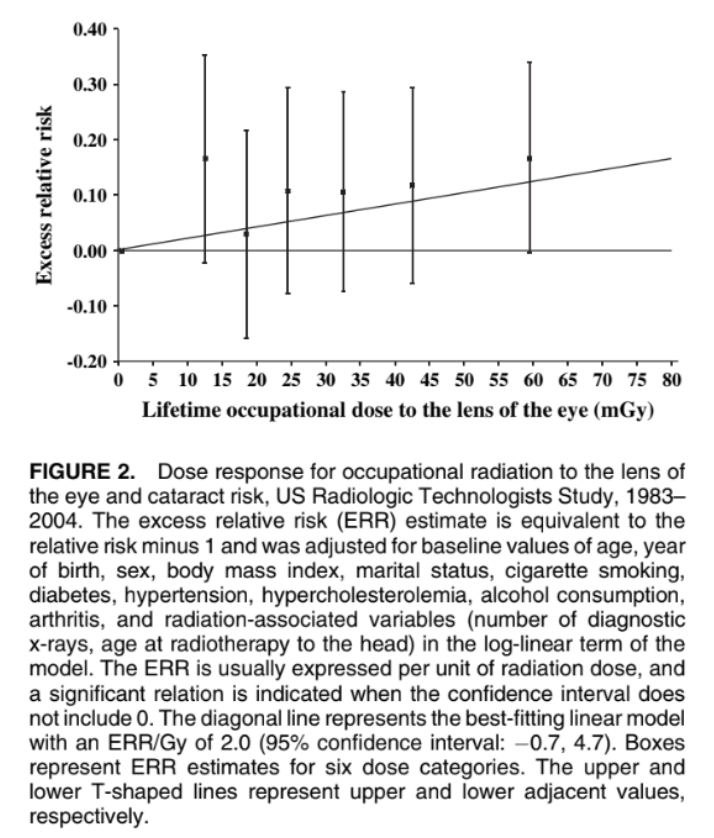Cardiac interventionists and others who work in the catheterization lab face occupational risks caused by radiation exposure as a result of their frequent participation in fluoroscopically guided cardiovascular procedures. There are many primary occupational risks of interventionists and their staff such as skin lesions, orthopedic illness, hypertension, and hypercholesterolemia. However, long-term radiation exposure can lead to even more severe risks associated with their work activities, such as cataracts and brain malignancies.
↑ Risk in Cataracts
Prolonged exposure to radiation can lead to orthopedic problems such as neck, back, hip, knee, and ankle pain. However, these issues can often be relieved with rest and conservative methods. A more serious concern in interventional cardiology is radiation-induced cataracts. Studies have shown a dose-dependent increased risk of cataracts among intervention cardiologists and nurses exposed to radiation.

Am J Epidemiol 2008; Chodick et al; Risk of Cataract after Exposure to Low
Doses of Ionizing Radiation: A 20-Year Prospective Cohort Study among US Radiologic Technologists
Cataract formation is a significant ocular complication associated with ionizing radiation exposure, with studies showing high rates of lens opacities among interventional cardiologists. Interventional cardiologists who work long-term in the catheterization lab are six times more likely to be diagnosed with cataracts than healthcare personnel not working in catheterization labs. Because of the increased risk of cataracts, it is important to wear protective glasses when working in the catheterization lab, but these glasses/goggles protect only the eyes, and the head remains exposed to radiation.
Since long-term radiation exposure among interventional cardiologists is linked to various negative health effects, the observations made in these obesity studies are alarming. While health problems associated with obesity in patients are well-established in literature, there is a need for further research to determine whether patient obesity might have an adverse impact on the health of staff and physicians who perform in the catheterization lab. With the prevalence of obesity increasing in the patient population, there is a greater need for radiation safety in the catheterization lab.
↑ Risk in Brain Malignancies
Recent reports have found an increased occurrence of brain tumors on the left side of the brain of interventionists, which is more exposed to radiation and less protected by traditional shielding methods. Studies found that long-term interventional cardiologists are three times more likely to have brain tumors than those not working in the catheterization lab. Very few have found a proper solution to protecting the brain when working in the catheterization lab. Though lead caps sufficiently reduce radiation exposure, they pose excessive discomfort and may cause disturbance during procedures.
The EggNest™ Solution
The EggNest™ by Egg Medical protects all parts of the body – including the head and the eyes – of all staff in the catheterization lab, without compromising workflow. Reducing radiation exposure by over 95%, the EggNest™ helps physicians and staff operate on patients more safely, significantly minimizing their risk of health issues such as cataracts and cancer.
